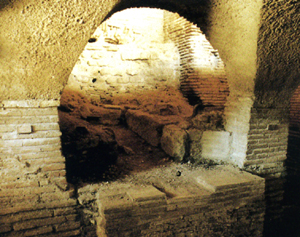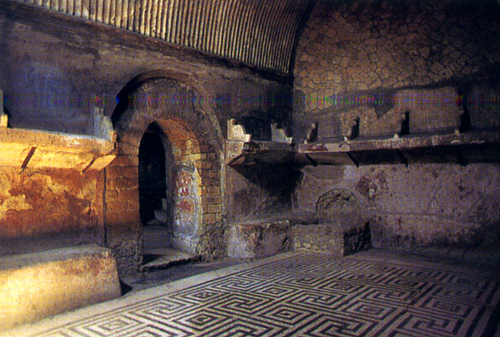|
Roman Baths
The Romans loved going to the baths. They went not only to swim but to relax, chat, enjoy a hot sauna, make a business deal, or to gamble. Roman baths were sumptuously decorated places of health, pleasure, and socialising that stood for the Roman way of life. To a Celt, Roman baths must have seemed very foreign and quite extraordinary.
Many Roman towns had baths, as well as army camps and rich men's villas. Mixed bathing was not allowed, so usually women visited in the morning and men in the afternoon. Everyone from rich to poor and even slaves was allowed in the baths.
A Visit to the Baths
A trip to the baths meant getting gradually hotter. Excavations of the baths at Wroxeter in Shropshire show the layout of the rooms and what a visitor might experience (see diagram to the right).
First was A, the palaestra, an open courtyard for exercising. Then the visitor entered the changing rooms, B, where he left his clothes. Next was C, the frigidarium, or cold room. Here the visitor had a cold bath to wash off most of his sweat and dirt. Next was D, the tepidarium, or warm room.
Finally there was E, the hot room, or caldarium. The hot room was filled was very hot steam, which opened the pores of the skin. Now a slave would scrape off the last of the sweat and dirt with a bronze scraper, called a strigil, and he could soak in a bath of hot water. An alternative to the caldarium in some baths was the laconicum, which was like a sauna - hot but dry.
After this the visitor would close his pores again in the frigidarium, and be rubbed down with oil.
Strigil and oil flask, in the Museum of London
Bath and Caerleon
Probably the best Roman baths to visit today in Britain are at Bath and at Caerleon in Wales.
Click here to see pictures of these two locations.
|
The open air bath at Bath. It was heated by a hot water spring.
Plan of the baths at Wroxeter
Aquae Sulis, now known as Bath. The baths are behind the forum. The roofs were vaulted (curved) and made of concrete, as timber would rot in the steam. |
|
Heating
One of the cleverest features of Roman baths was their heating. The caldarium and tepidarium were heated by furnaces burning wood to heat enormous tanks of water to supply the hot water and the steam. Also, there was a hypocaust system - that is, furnaces heated air which was directed into a space under the floor of the hot rooms. The floors were supported by short pillars, which you can see in many Roman baths, and also some houses. The cooler temperature of the tepidarium was a result of it being further away from the furnaces.
Water Supply
Roman baths, as you can guess, required an awful lot of water. One of the greatest achievements of the Romans, in fact, was how they got water to their towns. Water was brought from springs or lakes by aqueducts - special channels made of stone or other waterproof materials. In some parts of the Roman Empire you can still see these enormous structures, but in Britain they were simply channels along the ground, probably lined with clay tiles.
In the town the water was carried by wooden and lead pipes to fountains (so ordinary people could get water for their homes) and to baths. The water flowing out from baths and fountains was used to flush public toilets out to a river.
Caldarium in Pompeii baths
Drawing of the circular bath at Bath, a frigidarium. You wouldn't catch me in one of those. |
Hypocaust under the floor of the baths in Beirut, Lebanon. The air entered through the door-like spaces in the sides.
Victorian picture of the hypocaust in the baths at Chester
A hearth used to heat the water
|
|
Caldarium in the baths at Herculaneum, Italy
Model of the Baths of Caracalla in Rome. The baths in Rome were enormous - thousands could visit in one day. |










